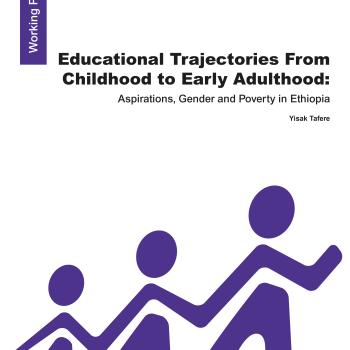Publication Information

This working paper discusses educational trajectories and gendered outcomes in early adulthood in Ethiopia. It is based on the Young Lives longitudinal study of a cohort of children born in 1994, the year when the first educational policy that set out the subsequent expansion of formal schooling in Ethiopia was launched.
Young Lives research has shown that children have gone through irregular education trajectories. Poverty, location, gender, and family situation all played pivotal roles in shaping their educational pathways.
While the national educational data indicate that the number of girls in primary school is almost equal to that of boys, Young Lives research suggests that girls fared well in both primary and secondary education. One implication is that gender parity is achieved at lower educational levels where girls are numerically better-off. Such gender parity in school may, nevertheless, disguise gender inequality that is more visible in adulthood. The national figure is biased towards boys in post-secondary education, and Young Lives research also indicates that the gender gap is narrowing and boys are catching up fast.
Young Lives research has also shown that children’s increased participation in formal education was inspired by the combination of expectations from the Millennium Development Goals (MDGs), the Ethiopian Government’s determination to expand education, and the high educational aspirations held by both children and parents. On the other hand, poverty, low quality of education, gender stereotypes, and the limited scope of the MDGs remain major challenges to educational achievements in Ethiopia. International promises have been renewed in the hope that these challenges can be addressed by moving from the MDGs to the Sustainable Development Goals (SDGs).
During this research, different policy interventions on poverty, education, and gender were in place, but there was little coordination in their application in the communities. The paper concludes that coordinated interventions on poverty reduction, quality education, and gender equality are required for children to achieve their aspirations from formal schooling.

This working paper discusses educational trajectories and gendered outcomes in early adulthood in Ethiopia. It is based on the Young Lives longitudinal study of a cohort of children born in 1994, the year when the first educational policy that set out the subsequent expansion of formal schooling in Ethiopia was launched.
Young Lives research has shown that children have gone through irregular education trajectories. Poverty, location, gender, and family situation all played pivotal roles in shaping their educational pathways.
While the national educational data indicate that the number of girls in primary school is almost equal to that of boys, Young Lives research suggests that girls fared well in both primary and secondary education. One implication is that gender parity is achieved at lower educational levels where girls are numerically better-off. Such gender parity in school may, nevertheless, disguise gender inequality that is more visible in adulthood. The national figure is biased towards boys in post-secondary education, and Young Lives research also indicates that the gender gap is narrowing and boys are catching up fast.
Young Lives research has also shown that children’s increased participation in formal education was inspired by the combination of expectations from the Millennium Development Goals (MDGs), the Ethiopian Government’s determination to expand education, and the high educational aspirations held by both children and parents. On the other hand, poverty, low quality of education, gender stereotypes, and the limited scope of the MDGs remain major challenges to educational achievements in Ethiopia. International promises have been renewed in the hope that these challenges can be addressed by moving from the MDGs to the Sustainable Development Goals (SDGs).
During this research, different policy interventions on poverty, education, and gender were in place, but there was little coordination in their application in the communities. The paper concludes that coordinated interventions on poverty reduction, quality education, and gender equality are required for children to achieve their aspirations from formal schooling.

